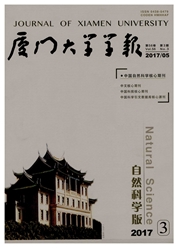

 中文摘要:
中文摘要:
A tiny number of Zn atoms were deposited on Si(111)-(797) surface to study the evolution process of Zninduced nanoclusters. After the deposition, three types(type I, II, and III) of Zn-induced nanoclusters were observed to occupy preferably in the faulted half-unit cells. These Zn-induced nanoclusters are found to be related to one, two, and three displaced Si edge adatoms, and simultaneously cause the depression of one, two, and three closest Si edge adatoms in the neighboring unfaulted half-unit cells at negative voltages, respectively. First-principles adsorption energy calculations show that the observed type I, II, and III nanoclusters can reasonably be assigned as the Zn3Si1, Zn5Si2, and Zn7Si3 clusters,respectively. And Zn3Si1, Zn5Si2, and Zn7Si3 clusters are, respectively, the most stable structures in cases of one, two, and three displaced Si edge adatoms. Based on the above energy-preferred models, the simulated bias-dependent STM images are all well consistent with the experimental observations. Therefore, the most stable Zn7Si3 nanoclusters adsorbed on the Si(111)-(797) surface should grow up on the base of Zn3Si1 and Zn5Si2clusters. A novel evolution process from Zn3Si1 to Zn5Si2, and finally to Zn7Si3 nanocluster is unveiled.
 同期刊论文项目
同期刊论文项目
 同项目期刊论文
同项目期刊论文
 Structural and electronic properties of germanene/MoS2 monolayer and silicene/MoS2 monolayer superla
Structural and electronic properties of germanene/MoS2 monolayer and silicene/MoS2 monolayer superla Performance evaluation ofmulti-junction solar cells by spatially resolved electroluminescence micros
Performance evaluation ofmulti-junction solar cells by spatially resolved electroluminescence micros Quantum state engineering with ultra-short-period (AlN)m/(GaN)n superlattices for narrowband deep-ul
Quantum state engineering with ultra-short-period (AlN)m/(GaN)n superlattices for narrowband deep-ul High Performance 3D Si/Ge Nanorods Array AnodeBuffered by TiN/Ti Interlayer for Sodium-Ion Batteries
High Performance 3D Si/Ge Nanorods Array AnodeBuffered by TiN/Ti Interlayer for Sodium-Ion Batteries 期刊信息
期刊信息
